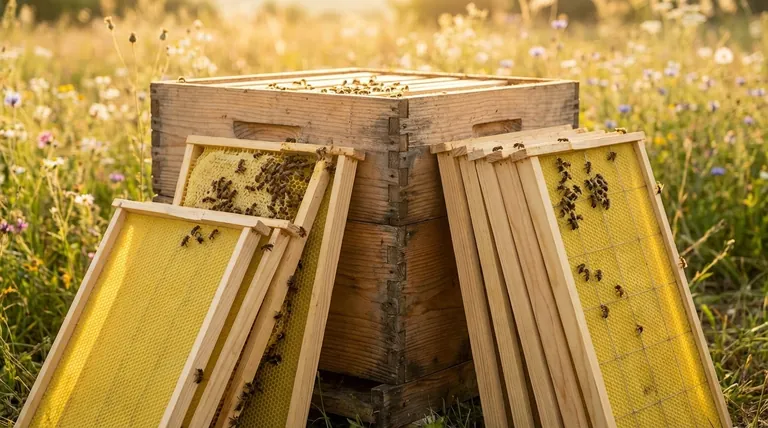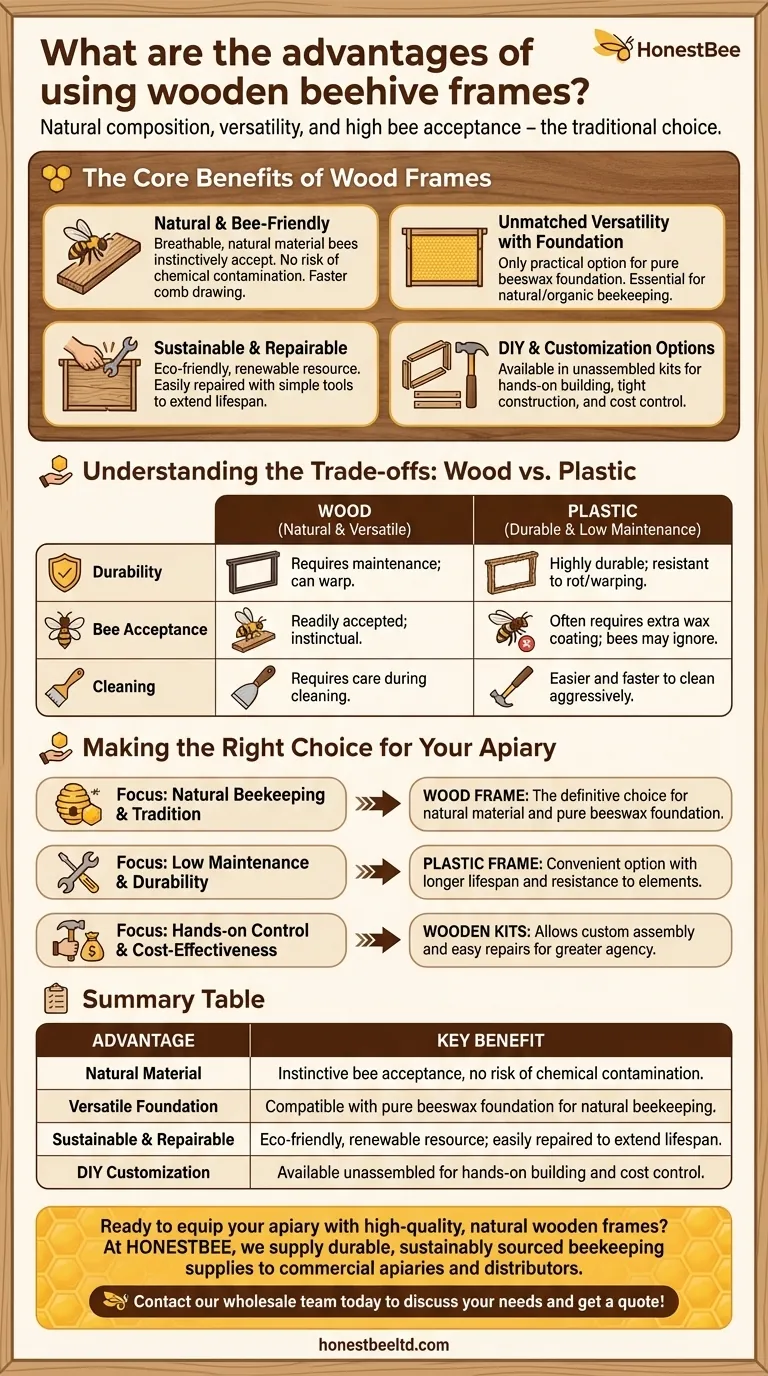At its core, the advantage of using wooden beehive frames lies in their natural composition, versatility, and high acceptance rate by bees. They are the traditional choice for beekeepers who prioritize a natural, sustainable environment for their colony and value the ability to repair their own equipment.
The decision between wooden and plastic frames is a fundamental one, boiling down to a trade-off between natural tradition and modern convenience. While plastic offers durability, wood remains the benchmark for its eco-friendly properties and how readily bees adapt to it.

The Core Benefits of Wood Frames
Wooden frames have been the standard in beekeeping for centuries for several key reasons. They align with a philosophy that seeks to provide bees with an environment that most closely mimics their natural habitat.
Natural and Bee-Friendly Material
Wood is a natural, breathable material that bees instinctively understand and accept. Colonies often adapt more quickly to wooden frames, readily drawing comb without the hesitation sometimes seen with synthetic alternatives.
This natural composition also means there is no risk of chemical contamination that could potentially harm the bees or seep into the honey.
Unmatched Versatility with Foundation
Frames provide the essential structure for bees to build their comb. Wooden frames offer unparalleled flexibility in what type of foundation—the starter sheet for the comb—you can use.
While they work with plastic foundation, wooden frames are the only practical option for beekeepers who wish to use a traditional pure beeswax foundation. This is a critical advantage for those practicing natural or organic beekeeping.
Sustainable and Repairable
As a renewable resource, wood is an eco-friendly choice. Unlike plastic, a damaged wooden frame can often be easily repaired with simple tools, extending its lifespan and reducing waste.
This repairability gives beekeepers greater control over their equipment and can lower long-term costs.
DIY and Customization Options
Wooden frames are available fully assembled, but they are also commonly sold in unassembled kits. This allows beekeepers to build their own frames, ensuring tight, square construction and offering a more hands-on connection to their craft.
Understanding the Trade-offs: Wood vs. Plastic
Choosing a frame material is not about finding a "perfect" option, but about understanding the compromises inherent in each choice. Your goals as a beekeeper will determine which material is the better fit.
The Durability Question
This is the primary advantage of plastic frames. Plastic is highly durable, resistant to warping in humid conditions, and will not rot. Wooden frames, by contrast, require more maintenance and can warp or break down over time if not cared for properly.
Bee Acceptance and Preparation
Bees readily accept and build comb on wooden frames. Plastic frames, on the other hand, almost always require an extra coating of beeswax to encourage the bees to begin working on them. Without it, bees may ignore the plastic foundation entirely.
Cleaning and Long-Term Use
Plastic frames are generally easier and faster to clean. You can scrape them down aggressively without worrying about damaging the material. While wooden frames are easily cleaned and reused, the process requires a bit more care to avoid damaging the wood.
Making the Right Choice for Your Apiary
Your beekeeping philosophy is the most important factor in this decision. There is no single "best" material, only the one that is best for you and your colony's specific needs.
- If your primary focus is natural beekeeping and tradition: Wood is the definitive choice, as it provides a natural material and is the only option for using pure beeswax foundation.
- If your primary focus is low maintenance and maximum durability: Plastic frames offer a longer lifespan and greater resistance to the elements, making them a more convenient option.
- If your primary focus is hands-on control and cost-effectiveness: Wooden frame kits allow for custom assembly and easy repairs, giving you more agency over your equipment.
Ultimately, selecting your frame material is about aligning your equipment with your goals for your apiary.
Summary Table:
| Advantage | Key Benefit |
|---|---|
| Natural Material | Instinctive bee acceptance, no risk of chemical contamination. |
| Versatile Foundation | Compatible with pure beeswax foundation for natural beekeeping. |
| Sustainable & Repairable | Eco-friendly, renewable resource; easily repaired to extend lifespan. |
| DIY Customization | Available unassembled for hands-on building and cost control. |
Ready to equip your apiary with high-quality, natural wooden frames?
At HONESTBEE, we supply durable, sustainably sourced beekeeping supplies and equipment to commercial apiaries and distributors. Our wooden frames are designed for superior bee acceptance and long-term value, supporting your commitment to natural beekeeping practices.
Contact our wholesale team today to discuss your needs and get a quote!
Visual Guide

Related Products
- Assembled Wooden Bee Frames with Beeswax Foundation Ready to Use by HONESTBEE
- HONESTBEE Wired and Assembled Wooden Bee Frames Foundation for a Thriving Hive
- Assembled Wooden Bee Frames with Plastic Foundation for Durability and Convenience by HONESTBEE
- Heavy-Duty Stainless Steel Clip-On Frame Perch
- Professional In-Hive Bee Feeder HONESTBEE Frame for Beekeeping
People Also Ask
- Can I reuse old frames? A practical guide to saving money and reducing waste
- What are bee frames, and how do they relate to box sizes? A Guide to the Langstroth Hive System
- How many frames fit in a 10 frame hive? A Guide to Maximizing Your Hive's Potential
- What are the main parts of a hive frame? A Guide to Modern Hive Anatomy
- What are some tips for setting up hive frames? Build a Strong Foundation for Your Hive



















